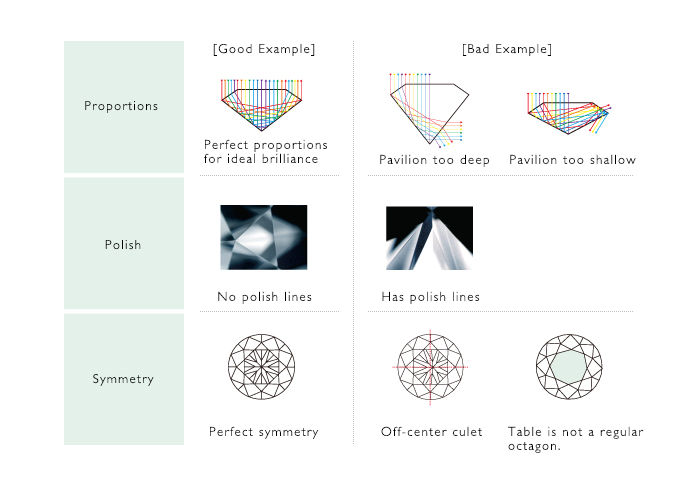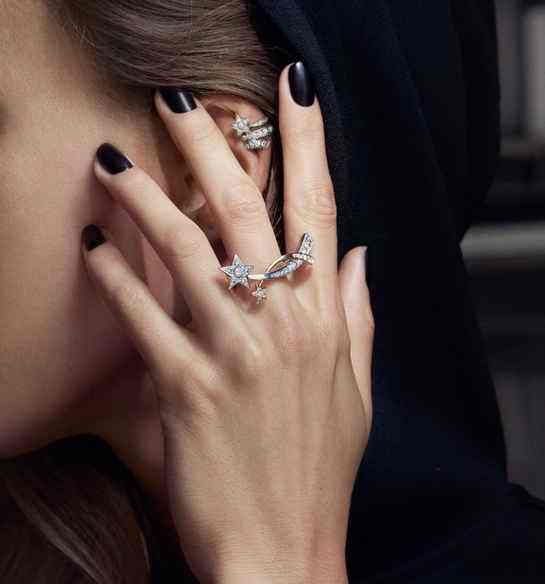
Diamond’s characteristic chemical composition and crystal structure make it a unique member of the mineral kingdom.
Diamond is the only gem made of a single element: It is typically about 99.95 percent carbon. The other 0.05 percent can include one or more trace elements, which are atoms that aren’t part of the diamond’s essential chemistry. Some trace elements can influence its color or crystal shape.
Whether fashioned or rough, and no matter what their shape, all diamonds have the same chemical composition and internal crystal structure.
The way a mineral forms helps determine its identity. Diamond forms under high temperature and pressure conditions that exist only within a specific depth range (about 100 miles) beneath the earth’s surface. Diamond’s crystal structure is isometric, which means the carbon atoms are bonded in essentially the same way in all directions. Another mineral, graphite, also contains only carbon, but its formation process and crystal structure are very different. The result is that graphite is so soft that you can write with it, while diamond is so hard that you can only scratch it with another diamond.
The most common shape for rough gem quality diamond is the octahedron, which looks like two pyramids back to back. Crystals that are almost perfect in shape and transparency are called glassies.
Without any one of these factors, diamond might be just another mineral. Fortunately, though, this special combination of chemical composition, crystal structure, and formation process gives diamonds the qualities that make them extraordinary.

Diamond is the hardest natural substance on Earth. It can cut any kind of rock or metal, but only another diamond can cut a diamond. In fact, to burn a diamond, it must be heated to between 1290-1650 degrees Fahrenheit. Yet the oil deposited from the mere touch of a human finger can cause dirt to collect and make this nearly indestructible gemstone quickly lose its sparkling appeal.
So how can you keep your diamond looking its very best? Here are some tips on keeping your diamond sparkling.
Diamonds are natural magnets for grease, so they’re not easy to keep clean. When a diamond is handled, the oils from your fingers adhere to the diamond’s surface and affect its brilliance and fire.
A simple plan to keep your diamond jewelry looking beautiful is to soak it in a gentle degreasing solution, such as water with a few drops of mild dish soap, once or twice a week. After you remove the diamond from the cleaning solution, use a soft, clean toothbrush to remove any remaining dirt. The toothbrush should be new and reserved exclusively for cleaning your jewelry. Use it to clean hard-to-reach places like the back of the diamond, which tends to collect the most oil and dirt.
Scrubbing your jewelry with a soft, clean toothbrush helps remove leftover dirt. Just be sure not to use on jewelry that is too fragile, such as estate jewelry, to avoid any potential damage. Photo by Eric Welch/GIA
Fragile settings, like older prongs in antique jewelry or a tension setting where the diamond is held in place by pressure from the shank, shouldn’t be vigorously scrubbed, so be gentle with the toothbrush. Then, just rinse your diamond jewelry with water and dry with a soft, lint-free cloth. If you’re working over a sink, make sure to close the drain.


If you know absolutely nothing about how to buy a diamond, you're in good company. Most people know little about the characteristics of diamonds or how to make an educated purchase.
Of course, that’s why we’re here. Our job is first and foremost to inform you, the buyer, when you shop for jewelry. We are passionate about connecting shoppers with educated and ethical jewelers so they have peace of mind while shopping for that important purchase.
We have precise standards for evaluating diamond quality, commonly known as the 4Cs: Cut, Color, Clarity and Carat Weight. These standards make it easy to compare different diamonds and understand their value.
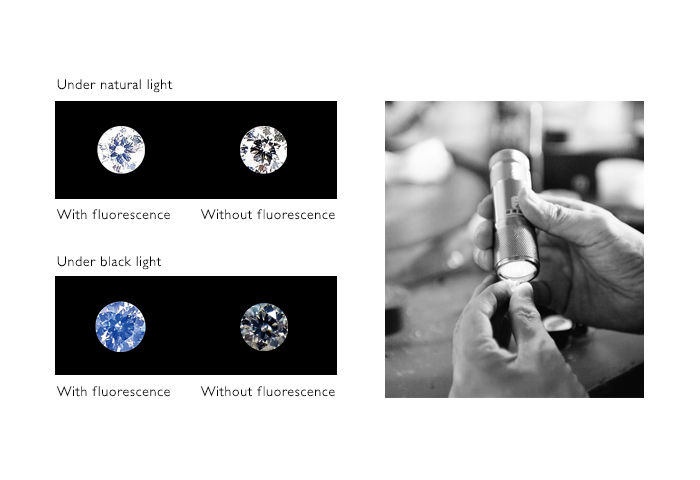
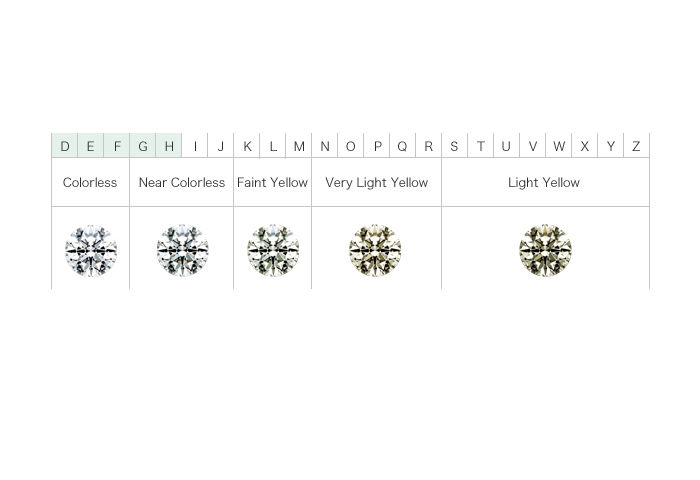
Determined based on the master stone (standard stone). The closer to colorless, the higher the rating. Conversely, those with a yellow tint have lower evaluations. However, diamonds are also pink and blue colored diamonds , and their color may be evaluated more than colorless. The highest is D, the following E, F, G… Z 23 stages. The following is a color guide.
DEF: transparent and colorless
GHIJ: Almost colorless
KLM: faint yellow
NR: very pale yellow
SZ: Light yellow
Judgment is made based on the size, position, and number of wounds and inclusions (inclusions). The best is "FL (Flawless)", hereinafter "IF (Internally Flawless)", "VVS (Very Very Slightly) 1", "VVS (Very Very Slightly) 2", "VS (Very Slightly) 1", "VS (Very Slightly)" There are a total of 11 levels from 2 to SI (Slightly Included) 1 to SI (Slightly Included) 2 to I (Imperfection) 1 to I (Imperfection) 2 to I (Imperfection) 3.
FL: Inclusions cannot be found both inside and outside even when magnified 10 times
IF: Minor flaws can be seen on the outside, but inclusions cannot be found even after expanding 10 times inside
VVS: 10x magnification makes it very difficult to find inclusions
VS: Finding inclusions is difficult at 10x magnification
SI: Inclusions are relatively easy to find at 10x magnification, but difficult with the naked eye
I: Inclusions can be easily found with the naked eye
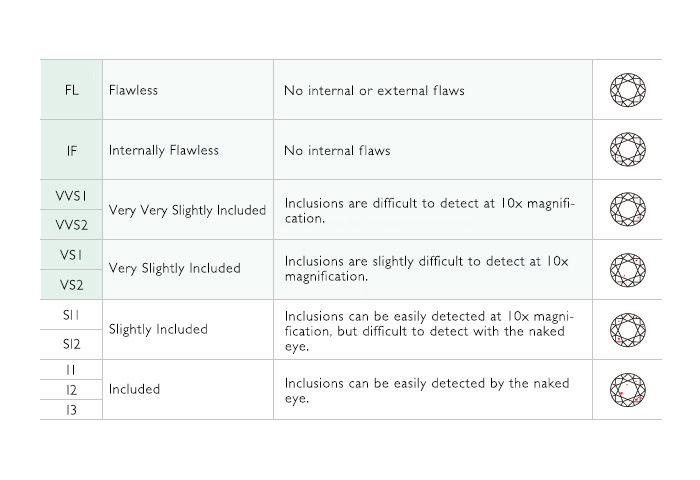
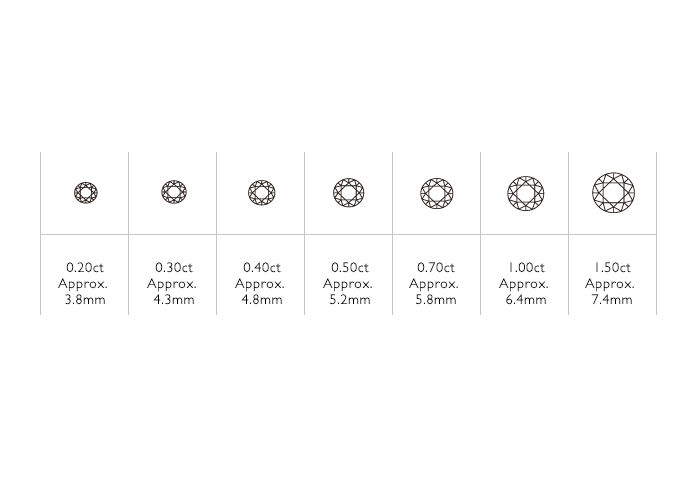
Stone weight. 1ct is 0.2g. Normally, it is expressed with two to three decimal places.
Etymology: Greek "Keratien" (caration / keration / carob)
With the locust beans weighing almost 0.2 g, it was just right to weigh jewelry, and gem traders used small, uniform beans as weights for their balances. At present, 1ct is 0.2g from the remnants.
There is another name according to the number of carats, and if it is less than 1 ct, it is also called "star size", "mere", "large mere", and it is 1 ct or more, such as "pointer", but there is no strict definition for the jewelry industry as a whole.
An element that is evaluated by only one hand. Only in the case of round brilliant cuts are the cuts evaluated. The proportion (shape) and finish (finish) are evaluated. Comprehensive evaluation is given in five levels from "EXCELLENT (EX)" to "VERY GOOD (VG)", "GOOD (G)", "FAIR (F)", "POOR (P)". In recent years, some improvements have been made to some of the 100-year-old round brilliant cuts, but these new cuts are not subject to this five-point rating. Therefore, the notation such as an appraisal report may be indicated only by the name of the cut. (Example: OE cut, Crown-K-Cut)
